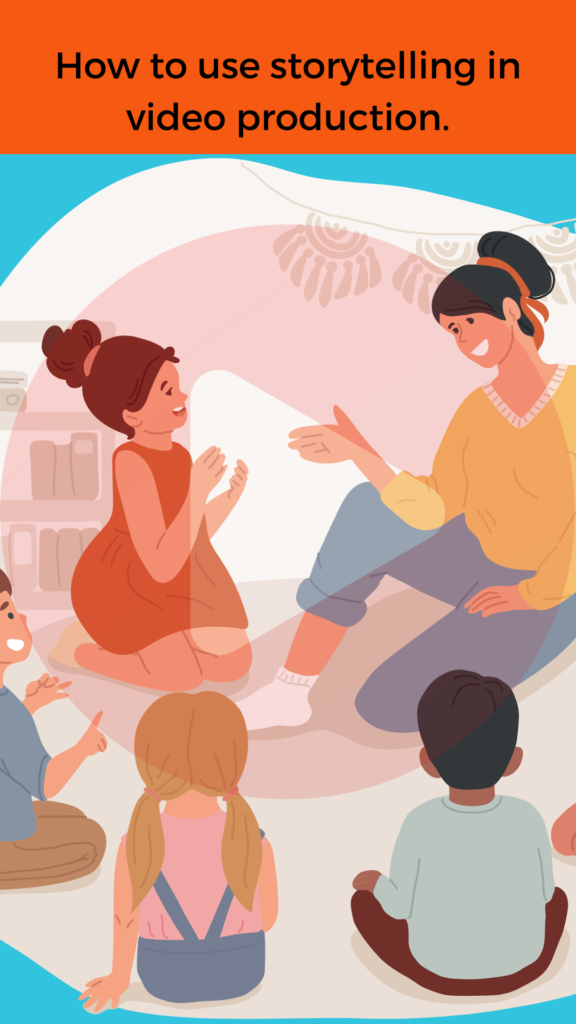
Effective video production relies heavily on storytelling, which serves as the foundation for engaging, informing, and evoking emotions in the audience. In this comprehensive exploration, we’ll examine storytelling’s various roles and its advantages and disadvantages.
1.Roles of Storytelling in Video Production.
Emotional Connection.
Stories can evoke emotions, making the audience laugh, cry, feel inspired, or even incited to action. This emotional engagement is crucial for memorable video content that resonates with viewers.
Message Clarity.
A well-crafted story helps clarify the video’s message or purpose. Through storytelling, complex ideas can be simplified and accessible to a broader audience, enhancing understanding and retention.
Audience Retention.
Engaging narratives keep the audience interested and invested in the video content. Storytelling can transform a mundane topic into an intriguing narrative, significantly improving viewer retention rates.
Brand Identity and Loyalty.
Stories can humanize brands, making them more relatable and trustworthy to the audience. Through storytelling, brands can share their values, history, and vision, fostering a stronger emotional connection and loyalty among their audience.
Differentiation.
Storytelling can set a video apart in a crowded media landscape. Unique and compelling stories can capture the audience’s attention and make the content stand out.
Motivation and Persuasion.
Effective storytelling can motivate the audience to take a desired action, such as purchasing a product, signing up for a service, or joining a cause. Stories can persuade more effectively than facts by appealing to the audience’s emotions and values.
2.Pros of Storytelling in Video Production.
Increases Engagement.
Stories are naturally engaging, making capturing and holding the audience’s attention easier.
Enhances Memory.
Emotional and relatable stories are more likely to be remembered, increasing the impact and recall of the video content.
Builds Emotional Bonds.
Storytelling can create a deep emotional connection with the audience, building empathy and trust.
Encouraging Sharing.
Compelling stories are more likely to be shared, extending the reach and impact of the video content.
3. Cons of Storytelling in Video Production.
Complexity and Time Consumption.
Crafting a compelling story can be complex and time-consuming, requiring more resources and planning than straightforward informational content.
Risk of Misinterpretation.
Different audiences can interpret stories in various ways, and the intended message may not be conveyed as expected.
Can Overshadow Facts.
In some cases, a strong narrative might overshadow the factual information, potentially leading to misinformation or a skewed understanding of the subject matter.
Potential for Emotional Manipulation.
There’s a fine line between engaging the audience emotionally and manipulating their feelings. Misuse of storytelling can lead to ethical concerns and backlash.
4. Some additional purposes.
Beyond the roles and implications already discussed, storytelling in video production can serve additional purposes and have further-reaching impacts, both creatively and strategically.
Cultural and Social Impact.
Stories can influence culture and societal norms. Through storytelling, video content can challenge stereotypes, foster inclusiveness, and promote social change by bringing underrepresented stories to the forefront.
Educational Value.
Storytelling can enhance educational content by making learning more engaging and memorable. Narratives can contextualize abstract concepts, making them easier to understand and relate to real-life scenarios.
Inspiration and Innovation.
Good storytelling can inspire viewers to think differently, encouraging creativity and innovation. Stories of triumph, innovation, and perseverance may motivate viewers to pursue their own ideas and solutions.
Historical Preservation.
Stories serve as a medium for preserving history and heritage. Using video storytelling, we can maintain and pass down critical historical events, traditions, and narratives to future generations, ensuring that valuable cultural and historical knowledge is preserved.
Enhanced Branding and Marketing Strategies.
Storytelling in branding and marketing can enhance brand recognition and consistency by creating a cohesive narrative across multiple channels.
Community Building.
Stories can unite people, creating a sense of community among viewers with similar experiences, values, or interests. Video content that tells stories reflecting shared struggles or achievements can foster a strong sense of belonging and community engagement.
International and Cross-Cultural Reach.
Storytelling in video production can transcend language barriers and cultural differences, making it possible to reach a global audience. A universally relatable story can resonate across different cultures, expanding the content’s impact and appeal.
Inclusivity and Representation.
Effective storytelling should strive for inclusivity and represent diverse voices and perspectives. This can enrich the narrative and ensure that a wider audience feels seen and heard.
Ethical Storytelling.
It’s crucial to approach storytelling with sensitivity and integrity, especially when dealing with real-life stories or sensitive topics. Ethical storytelling respects the subjects and their experiences and avoids sensationalism and exploitation.
Adapting to Audience Preferences.
Understanding the target audience’s preferences and expectations can help tailor stories to meet their interests and needs, enhancing engagement and effectiveness.
Conclusion.
In summary, storytelling in video production is not just a tool for engagement or a method for conveying messages; it’s a multifaceted approach that can inspire, educate, preserve, and connect. The power of storytelling extends far beyond a video’s immediate impact, profoundly influencing culture, education, and social norms. However, to be used effectively, storytelling requires careful planning, ethical consideration, and a balance between narrative and factual information.
